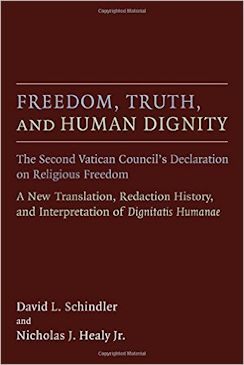
|
Posted January 4, 2016
Book: Freedom, Truth, and Human Dignity The Second Vatican Council's Declaration on Religious Freedom Authors: David L. Schindler and Nicholas J. Healy Jr. An Excerpt from the Jacket:
In this book David L. Schindler and Nicholas J. Healy Jr. promote a deeper understanding of the Second Vatican Council's Declaration on Religious Freedom -- Dignitatis Humanae -- which Pope Paul VI characterized as one of the greatest documents of Vatican II. In addition to presenting a new translation of the approved text on the Declaration, they make available for the first time in English the five schemas (drafts) of the document that were presented to the Council bishops leading up to the final version. The book also includes an original interpretive essay on Dignitatis Humanae by Schindler and an essay on the genesis and redaction history of the text by Healy. An Excerpt from the Book: The General Principle of Religious Freedom (The object and foundation of religious freedom). This Vatican Council declares that the human person has a right to religious freedom. Such freedom consists in this, that all men and women should be immune from coercion on the part of individuals, social groups or any human power, so that no one is forced to act against his conscience, in private or in public, whether alone or in association with others, within due limits. In addition, this Council declares that the right to religious freedom has its foundation in the very dignity of the human person, as known from both the revealed word of God and reason itself. This right of the human person to religious freedom must be acknowledged in the juridical order of society, so that it becomes a civil right. It is in accord with their dignity that all men and women, because they are persons, endowed with reason and free will and therefore privileged with personal responsibility, are impelled by their nature and bound by a moral obligation to seek the truth, especially the truth concerning religion. They are also bound to hold fast to the truth once it is known, and to order their whole life in accord with its demands. They cannot satisfy this obligation in a way that is in keeping with their own nature, however, unless they enjoy psychological freedom as well as immunity from external coercion. The right to religious freedom does not have its foundation in the subjective disposition of the person, therefore, but rather in his very nature. Consequently, the right to this immunity persists even for those who do not satisfy their obligation to seek the truth and to hold fast to it; the exercise of this right is not to be impeded, provided that just public order is preserved. Table of Contents: 1. The Declaration on Religious Freedom 2. Freedom, Truth and Human Dignity: An interpretation of Dignitatis Humanis on the right to religious freedom. 3. The drafting of Digniatatis Humanae 4. The five conciliar schemas 5. Schema 3 and the final text. Appendix 1: The conciliar interventions of Karol Wojtyla Appendix 2: The conciliar intervention of Alfred Ancel |
|
